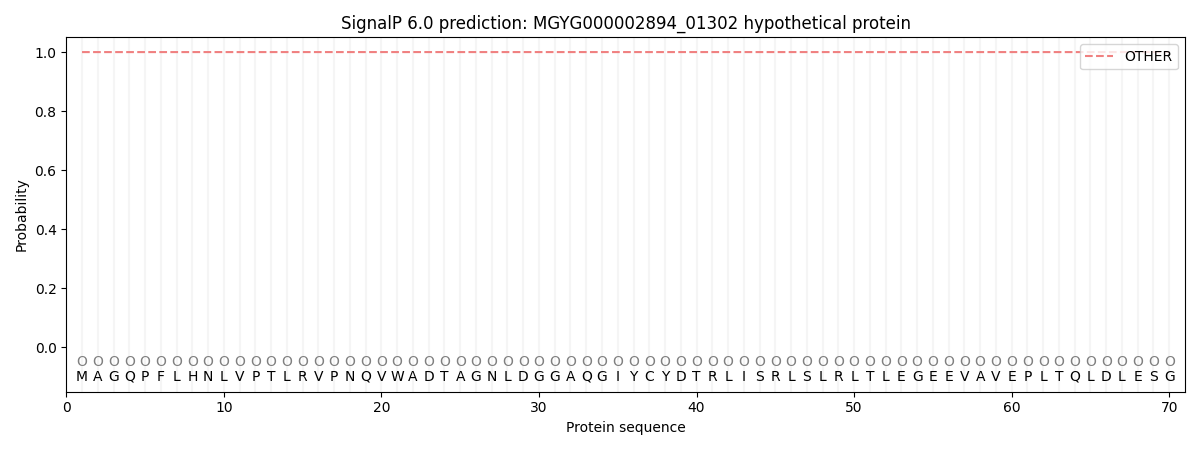You are browsing environment: HUMAN GUT
CAZyme Information: MGYG000002894_01302
You are here: Home > Sequence: MGYG000002894_01302
Basic Information |
Genomic context |
Full Sequence |
Enzyme annotations |
CAZy signature domains |
CDD domains |
CAZyme hits |
PDB hits |
Swiss-Prot hits |
SignalP and Lipop annotations |
TMHMM annotations
Basic Information help
| Species | Winkia sp002849225 | |||||||||||
|---|---|---|---|---|---|---|---|---|---|---|---|---|
| Lineage | Bacteria; Actinobacteriota; Actinomycetia; Actinomycetales; Actinomycetaceae; Winkia; Winkia sp002849225 | |||||||||||
| CAZyme ID | MGYG000002894_01302 | |||||||||||
| CAZy Family | GH0 | |||||||||||
| CAZyme Description | hypothetical protein | |||||||||||
| CAZyme Property |
|
|||||||||||
| Genome Property |
|
|||||||||||
| Gene Location | Start: 11131; End: 13035 Strand: + | |||||||||||
CDD Domains download full data without filtering help
| Cdd ID | Domain | E-Value | qStart | qEnd | sStart | sEnd | Domain Description |
|---|---|---|---|---|---|---|---|
| COG3408 | GDB1 | 5.63e-68 | 220 | 626 | 230 | 602 | Glycogen debranching enzyme (alpha-1,6-glucosidase) [Carbohydrate transport and metabolism]. |
| pfam14742 | GDE_N_bis | 1.22e-14 | 19 | 141 | 7 | 132 | N-terminal domain of (some) glycogen debranching enzymes. This domain is found on the N-terminal of some glycogen debranching enzymes and is usually followed by the GDE_C (PF06202) and in this sense it is analogous (but probably not homologous) to the GDE_N (PF12439). Its exact function is unknown |
| pfam06202 | GDE_C | 5.07e-14 | 261 | 622 | 22 | 371 | Amylo-alpha-1,6-glucosidase. This family includes human glycogen branching enzyme AGL. This enzyme contains a number of distinct catalytic activities. It has been shown for the yeast homolog GDB1 that mutations in this region disrupt the enzymes Amylo-alpha-1,6-glucosidase (EC:3.2.1.33). |
| pfam17389 | Bac_rhamnosid6H | 4.37e-04 | 338 | 475 | 87 | 217 | Bacterial alpha-L-rhamnosidase 6 hairpin glycosidase domain. This family consists of bacterial rhamnosidase A and B enzymes. L-Rhamnose is abundant in biomass as a common constituent of glycolipids and glycosides, such as plant pigments, pectic polysaccharides, gums or biosurfactants. Some rhamnosides are important bioactive compounds. For example, terpenyl glycosides, the glycosidic precursor of aromatic terpenoids, act as important flavouring substances in grapes. Other rhamnosides act as cytotoxic rhamnosylated terpenoids, as signal substances in plants or play a role in the antigenicity of pathogenic bacteria. |
CAZyme Hits help
| Hit ID | E-Value | Query Start | Query End | Hit Start | Hit End |
|---|---|---|---|---|---|
| QNN52328.1 | 2.71e-164 | 2 | 630 | 3 | 618 |
| AUZ33084.1 | 4.12e-155 | 1 | 630 | 1 | 633 |
| QDP97248.1 | 3.70e-152 | 4 | 629 | 5 | 620 |
| ADX74079.1 | 1.17e-151 | 1 | 630 | 1 | 633 |
| SDT32008.1 | 2.66e-150 | 4 | 629 | 9 | 613 |
Swiss-Prot Hits help
SignalP and Lipop Annotations help
This protein is predicted as OTHER

| Other | SP_Sec_SPI | LIPO_Sec_SPII | TAT_Tat_SPI | TATLIP_Sec_SPII | PILIN_Sec_SPIII |
|---|---|---|---|---|---|
| 1.000055 | 0.000001 | 0.000000 | 0.000000 | 0.000000 | 0.000000 |
